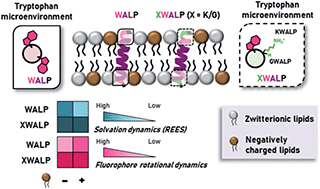Membrane electrostatics sensed by tryptophan anchors in hydrophobic model peptides depends on non-aromatic interfacial amino acids: implications in hydrophobic mismatch†
Abstract
WALPs are synthetic α-helical membrane-spanning peptides that constitute a well-studied system for exploring hydrophobic mismatch. These peptides represent a simplified consensus motif for transmembrane domains of intrinsic membrane proteins due to their hydrophobic core of alternating leucine and alanine flanked by membrane-anchoring aromatic tryptophan residues. Although the modulation of mismatch responses in WALPs by tryptophan anchors has been reported earlier, there have been limited attempts to utilize the intrinsic tryptophan fluorescence of this class of peptides in mismatch sensors. We have previously shown, utilizing the red edge excitation shift (REES) approach, that interfacial WALP tryptophan residues in fluid phase bilayers experience a dynamically constrained membrane microenvironment. Interestingly, emerging reports suggest the involvement of non-aromatic interfacially localized residues in modulating local structure and dynamics in WALP analogs. In this backdrop, we have explored the effect of interfacial amino acids, such as lysine (in KWALPs) and glycine (in GWALPs), on the tryptophan microenvironment of WALP analogs in zwitterionic and negatively charged membranes. We show that interfacial tryptophans in KWALP and GWALP experience a more restricted microenvironment, as reflected in the substantial increase in magnitude of REES and apparent rotational correlation time, relative to those in WALP in zwitterionic membranes. Interestingly, in contrast to WALP, the tryptophan anchors in KWALP and GWALP appear insensitive to the presence of negatively charged lipids in the membrane. These results reveal a subtle interplay between non-aromatic flanking residues in transmembrane helices and negatively charged lipids at the membrane interface, which could modulate the membrane microenvironment experienced by interfacially localized tryptophan residues. Since interfacial tryptophans are known to influence mismatch responses in WALPs, our results highlight the possibility of utilizing the fluorescence signatures of tryptophans in membrane proteins or model peptides such as WALP as markers for assessing protein responses to hydrophobic mismatch. More importantly, these results constitute one of the first reports on the influence of lipid headgroup charge in fine-tuning hydrophobic mismatch in membrane bilayers, thereby enriching the existing framework of hydrophobic mismatch.

- This article is part of the themed collection: Peptide-membrane interactions


 Please wait while we load your content...
Please wait while we load your content...